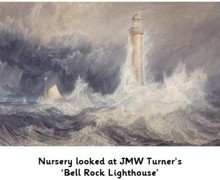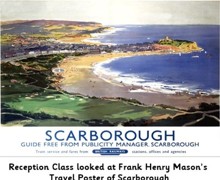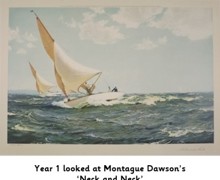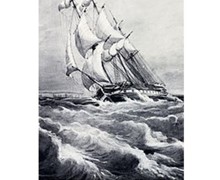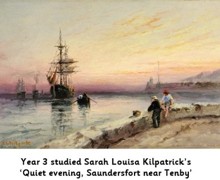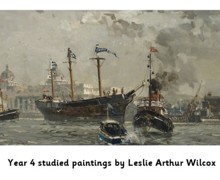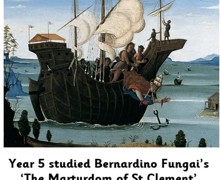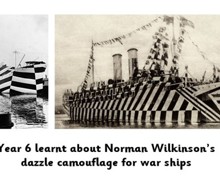Latest News
Nautical Art
Posted on: 22/11/201923rd November is the special feast day of our school's saint, St Clement.
Saint Clement is recognised is considered a patron saint of mariners. In celebration, today we all dressed in nautical-themed clothes and most classes looked at the artwork of a British maritime artist. Year 5 studied the work of the Italian painter, Bernardino Fungai, whose artwork depicted Saint Clement.
Nursery looked at an artwork by JMW Turner. Turner was an English painter, best known for his expressive and imaginative landscapes and turbulent marine paintings. Turner was born very near our school in Maiden Lane, Covent Garden. He lived in London all his life, retaining his cockney accent and assiduously avoiding the trappings of success and fame. A child prodigy, Turner studied at the Royal Academy of Arts from 1789, enrolling when he was 14.
Reception Class talked about times they have been to the seaside and places they have visited. They looked at a picture by Frank Henry Mason (1875-1965) and created their own artwork. Frank Henry Mason was an English artist best known for his maritime, shipping, coastal and harbour paintings, and as a creator of art deco travel and railway posters. His style is described as 'light impressionist' and he was a founder member of the Staithes Art Club whose members are known today as the Staithes group of artists, or the Northern Impressionists.
Year 1 children studied an artwork by Montague Dawson (who happens to share the same surname as Year 1's teacher!). Mr Dawson was a British painter who was renowned as a maritime artist. His most famous paintings depict sailing ships, usually clippers or warships of the 18th and 19th centuries. He was the son of a keen yachtsman and the grandson of the marine painter Henry Dawson (1811–1878), born in Chiswick, London. Much of his childhood was spent on Southampton Water where he was able to indulge his interest in the study of ships. For a brief period around 1910 Dawson worked for a commercial art studio in Bedford Row, London, but with the outbreak of the First World War he joined the Royal Navy. In 1924 Dawson was the official artist for an Expedition to the South Seas by the steam yacht St George. During the expedition he provided illustrated reports to the Graphic magazine.
Year 2 studied an artwork by Sir Oswald Walters Brierly (1817 - 1894). Sir Oswald was an English marine painter. He was the son of Thomas Brierly, a doctor and amateur artist, who belonged to an old Cheshire family. After a general grounding in art at the academy of Henry Sass in Bloomsbury, he went to Plymouth to study naval architecture and rigging.
Year 3 learned about Sarah Louisa Kilpatrick. She was a British artist who is best known for her portrayals of stormy coastal scenes. Born in our very own Covent Garden, Sarah was described as a talented, shy child who enjoyed artistic pursuits including drawing and music.
Year 4 studied the work of Leslie Arthur Wilcox, an English artist known mainly for his marine works in oils. He was also a watercolourist, illustrator, poster artist, marine model-maker and author. He was for some years Honorary Secretary of the Royal Society of Marine Artists and a member of the Royal Institute of Painters in Water Colours. His works are in many collections around the world, including the National Maritime Museum in Greenwich, and the Royal Collection. He wrote and illustrated two books on maritime history: Mr Pepys' Navy and Anson's Voyage.
Year 5 studied two works by Bernardino Fungai. In Fungai's art, clear spring water miraculously gushes forth from bone-dry rock as St Clement strikes the stone with his pickaxe. St Clement was exiled to the island of Chersonesus as punishment for his Christian faith. Here, he toiled under intense heat in the marble quarries, without any drinking water for relief. St Clement prayed to God and was led by a lamb to the source of refreshment. The iconography is drawn from the Golden Legend. Bernardino Fungai was a master of the Sienese School, celebrated for his use of gold and depiction of luxury materials.
Year 6 studied the work of Norman Wilkinson. Wilkinson usually worked in oils and watercolorus. He was primarily a marine painter but also an illustrator and poster artist. Wilkinson invented 'dazzle painting' of ships to camouflage and protect merchant shipping during the First World War.
Take a look at the images in our gallery below:

